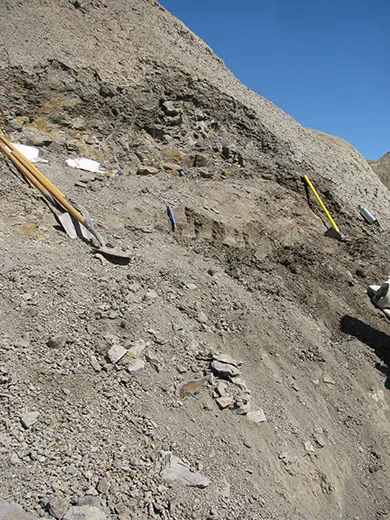Wyoming Paleontology Dispatch #1: Why 56 Million Years Ago?
What did the earth look like during the Paleocene Epoch? A Smithsonian researcher investigates
/https://tf-cmsv2-smithsonianmag-media.s3.amazonaws.com/filer/Wyoming-Dispatches-packed-truck-631.jpg)
It was 39 summers ago that I first came to the Bighorn Basin in northern Wyoming to do paleontological fieldwork. I was just out of high school then, had no experience collecting fossils and felt unbelievably lucky to be included. (I had taken a paleontology class at the local university and had wrangled a spot on the trip through my professor.) I still feel lucky to be able to come out here every summer, partly because of the beautiful landscape, partly because it gives me a month outdoors and away from e-mail and phone messages, but mostly because this is a place where I can pursue the endless question I have about what the earth was like millions of years ago.
This summer, as in many past, I am focused on a period of time 56 million years ago, just as the Paleocene Epoch passed into the Eocene. The Paleocene, which began about 66 million years ago, was the first part of the “Age of Mammals” that followed the extinction of the dinosaurs. The climate was mild. The Eocene was generally even warmer than the Paleocene; palm trees grew in central Montana and alligator relatives swam in the Arctic Ocean. I’m giving this transition from the Paleocene to the Eocene special attention because of a strange climatic event, a period of rapid global warming called the Paleocene-Eocene Thermal Maximum, often abbreviated PETM. The PETM lasted “only” about 200,000 years, but it was a busy time. In the first 10,000 years of the event, global temperature increased by about 4 to 8 degrees Celsius (or 7 to 14 degrees Fahrenheit) and the deep ocean became more acidic. This was all caused by a very large release of carbon into the ocean and atmosphere, though we aren’t sure yet where the carbon came from. Many scientists think there were several sources, probably including methane ice deposits in the ocean floor as well as carbon dioxide from volcanic activity. The parallels to human-caused global warming are strong, and that’s why so many of my colleagues and I are interested in the PETM.
Why come to Wyoming to study the PETM? Between 50 million and 60 million years ago the Bighorn and Bear Tooth mountains were rising rapidly, pushed up by forces deep within the earth, and as they rose they eroded. The sediment shed from their sides was carried into the low-lying Bighorn Basin by streams, eventually piling up miles thick and causing the bottom of the basin to sink under the added weight. The muddy and sandy sediments encased the remains of countless animals and plants. Much to the delight of paleontologists, the Bighorn Basin has many areas where those sediments deposited 50 million to 60 million years ago are being carved by wind and water into badlands and where the fossils within them are now exposed at the surface. This is probably the finest place in the world to collect fossils from the late Paleocene and early Eocene, and that’s what has drawn me back every year for most of my life.
For the first part of the field season, I will be doing what I usually do—looking for places to collect plant fossils, mostly fossil leaves, from the band of rock about 120 feet thick that represents the PETM. When we find them my crew and I will spend long hours in the hot sun digging rocks out of the hillside, splitting them open, examining them for fossils, and carefully wrapping the “keepers” for transport back to the Smithsonian’s National Museum of Natural History in Washington.
Beginning on July 13, for 7 to 10 days we will be doing something new and different—drilling a core through rocks deposited during the PETM near the town of Basin, Wyoming. We will be working with a large international crew of scientists and drillers from the Ruen Company. The goal of this project is to recover the most complete possible record of the PETM in rocks that have never been exposed since they were deposited 56 million years ago. We hope they will contain microscopic fossils of pollen and also chemical fossils—compounds made by the plants that lived during the PETM. The fossil pollen and the fossil molecules derived from these ancient plants have the potential to help us develop a detailed record of how the climate changed during this ancient global warming episode and how plant life responded to the climate. It seems like important information to know given how rapidly we humans are changing the climate.
Scott Wing is a research scientist and curator in the Smithsonian Institution’s Department of Paleobiology
/https://tf-cmsv2-smithsonianmag-media.s3.amazonaws.com/accounts/headshot/SLW_photo_-James_Kegley_for_Smithsonian.jpg)


/https://tf-cmsv2-smithsonianmag-media.s3.amazonaws.com/accounts/headshot/SLW_photo_-James_Kegley_for_Smithsonian.jpg)